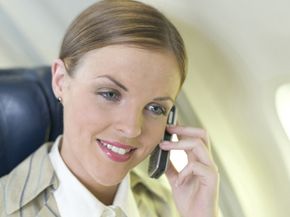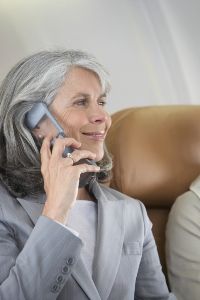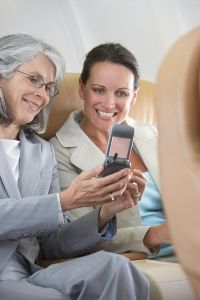Before talking about in-flight mobile phone services, let's look at how cell phones work on the ground.
Despite its name, a cell phone is a two-way radio. However, it's more sophisticated than a citizen's band radio or walkie-talkie.
CB radios and walkie-talkies are simplex devices, meaning they use one channel to communicate. Because they use one channel, only one person can talk at a time.
A cell phone, however, is a duplex device. It switches back and forth between two frequencies -- one for talking, or transmitting; the other for listening, or receiving.
Will traditional cell phones work on planes? The New York Times reported that cell phones can be used in a flight's ascent and descent portions, but that their ability to work decreases as the plane climbs higher.
More airlines are adapting technology that allows passengers to use in-flight mobile services.
As of September 2007, Airbus passengers could make and receive phone calls and send text messages using their cell phones while flying at about 10,000 feet. The service cost passengers $2.50 a minute and 50 cents per message, the International Herald Tribune reported.
The service provider, OnAir, uses special equipment to route calls and messages through a satellite network, which patches it into the ground-based network. The airplane crew controls the system and can limit or disable its use.
Pico cell technology allows passengers to use their own cell phones on planes. Pico cells serve very small areas. In ground-based networks, they're used to serve areas such as a building's interior where signals are weak, or to boost network capacity. A Pico cell on a plane combines electronic equipment with an onboard antenna. The passengers' calls are sent to the central antenna and relayed to ground towers.
Even if in-flight cell phone service was available, it's not clear whether people would use it. A survey by travel management company Carlson Wagon-lit Travel showed that 61 percent of business travelers oppose using their phones in a plane. In response, airlines are looking at other ways to meet travelers' communications needs, such as high-speed Internet access.
AirCell helps U.S.-based airlines provide that service. The company's service allows passengers to surf the Internet, check e-mail and send attachments, as well as log into their office network from 35,000 feet.
More airlines, foreign and domestic, are pursuing this option, too.
The New York Times, in December 2007, reported some American airlines were offering in-flight Internet service. JetBlue Airways offers instant messaging while Virgin America and Alaska Airlines offer Web access. Experts predict in-flight Web access will be common within a few years.
American Airlines also announced it would test high-speed Internet service for its passengers in 2008 on its Boeing 767-200 aircraft, which primarily fly international routes. The technology will use three exterior antennas mounted on the aircraft. It will rely on a network of cell towers throughout the United States.
American Airline officials said the service is for their customers who rely on PDAs and laptops for real-time information and communications.
Even though wireless Web access could be used to make phone calls, most air carriers said they had no plans to allow voice communications. Airlines worried the chatter from cell phone users would annoy other travelers, while quietly browsing one's e-mail or surfing the Web wouldn't.
Besides an increase in chatter, what are the actual safety concerns with in-flight mobile phone services? Check out the next page to find out.





